You Made Bankers Rich!
- By focusing only on monthly payments, Americans overpay their bankers.
- That’s because only in America can you get a 30-year fixed mortgage.
- Outside the US, mortgage rates are fixed for a shorter time, then become variable.
Greetings from beautiful Il Piemonte!
I had such a good laugh earlier this week.
If you’ve been reading the Rude, you know that my in-laws are visiting from the Philippines, and we are doing our best to entertain them. We’re driving them around Italy, trying to introduce them to new food and wine, and generally showing them a great time.
To restock the fridge, Pam and I went food shopping the other day. I noticed Pam pick up a jar of Nescafé instant coffee.
I said, “Who is that for?”
She said, “My parents.”
I said, “Isn’t that what they drink at home?”
Pam said, “Yes.”
I asked, “Why would they want to drink that here when they’ve got all this wonderful Italian coffee around them?”
She said, “Well, they don’t like it very much…”
Of course, the Italian in me recoiled. But the economist in me thought, “Well, that’s their preference.”
Steak a la Trump
I have a confession to make.
Growing up in New Jersey, my mother made London Broil for the family at least once a week.
It was always well done, and I always ate it with ketchup.
So when people started making fun of Donald Trump, I never entirely understood why.
Don’t get me wrong. There are better ways to prepare a steak.
For instance, in London in the early Naughties, my good friend Freddie made fun of me at the Gaucho Grill in Shepherd Market, one of our favorite Argentinian steakhouses.
He challenged me to give up my American obsession with “burned” steak and eat a “blue” steak. In British terms, a blue steak is a barely seared and cold (raw) in the middle. Freddie said how much you cook your steak and how smart you are, are inversely proportional.
So I took him up on this challenge and ordered a blue steak with béarnaise sauce.
The flavor exploded in my mouth. I had never eaten something so delectable, and I quickly understood why Europeans love their steaks practically raw.
Now I prefer my steaks blue. But I don’t frown upon people who like their steaks well done or with ketchup instead of béarnaise sauce.
And that’s the issue. What are people’s preferences?
Some of “their” preferences defy “our” expectations. We think these people are crazy, but they’re ideally within their rights to choose something we may feel is not in their best interests.
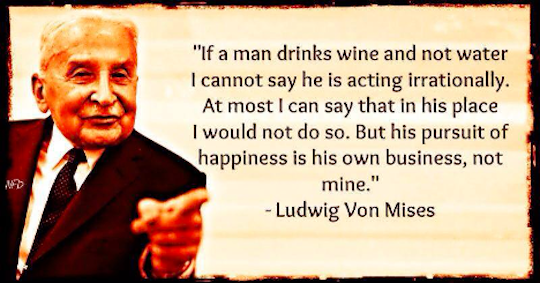
Now imagine these preferences comingling with government-sponsored incentives.
Preferences and Incentives
“Show the incentives, and I’ll show you the outcome,” famously said Charlie Munger, ace coffin dodger and bestie of Warren Buffett.
Governments incentivize people to stay in one place. That makes it easier to keep tabs and collect taxes.
And nothing will keep you in one place better than owning your house. And if you can’t pay cash for your house – and most people can’t – then the government would need to set up a long-term financing scheme to get you your house and keep you there.
In his excellent book, Walk Away: The Rise and Fall of the Homeownership Myth, Doug French writes:
In his book American Individualism, Herbert Hoover viewed American individualism stripped of “the laissez-faire of the 18th century” as Abraham Lincoln’s “ideal of equality of opportunity” whereby “fair division can only be obtained by certain restrictions on the strong and dominant.”
Hoover associated homeownership with independence and initiative, believing that an American must own a home to be considered a true American. Disturbed that the 1920 census showed a decline in homeownership, “Hoover offered a vigorous, new approach to the housing problem through the application of federal, voluntary, and business cooperative activity,” Janet Hutchinson writes in “Building for Babbitt: The State and the Suburban Home Ideal.” At Hoover’s direction, the federal government threw its weight behind four organizations to promote homeownership: the commercial “Own Your Own Home Campaign” and Home Modernization Bureau, the nonprofit Better Homes in America Movement, and the professional Architects’ Small House Service Bureau. This concentrated effort served to foster, as Hutchison points out, “an idealized vision of American home life rooted in the ownership of a suburban residence replete with modern amenities.”
So while it may seem that Americans by their nature have genes that make them aspire to homeownership, this notion is nonsense. “Homeownership was sold to Americans with “carefully calculated governmental policies that proselytized Americans about the virtues of suburban homeownership while opposing outright market intervention,” explains Hutchison.
With that in mind, let’s look at the United States mortgage market.
You Made Bankers Rich
Oh, you didn’t mean to. But what did you expect?
As of the end of 2022, the total mortgage debt outstanding is $11.92 trillion.
Even if all mortgages carried a 1% interest rate, that’s still $119,200,000 billion in revenue for the banks. That’s a lot of pasta!
If that were spread evenly across the roughly 5,000 banks and credit unions the FDIC insures, that’s $23 million in revenue each.
But we know that’s not how it works.
JP Morgan alone had $43 billion in revenue for the second quarter of 2023. But it’s not even the biggest mortgage lender in the US.
Here’s a list of the largest US mortgage lenders:

Credit: ADV Ratings
Rocket Mortgage, the biggest lender, earned $5.8 billion in revenue for 2022 on their loan originations of $133 billion.
Do you know who paid these guys? You did.
And in America, it makes complete sense.
American Homeownership Versus European Homeownership
What’s the difference between these two types of homeownership?
In a nutshell: the 30-year fixed mortgage.
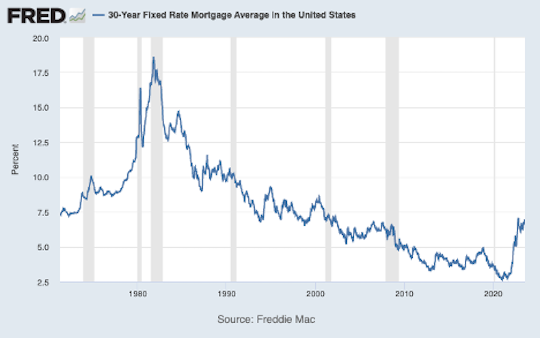
Credit: FRED
Americans have access to these. Most Europeans do not.
And it makes an enormous difference.
Let’s look at how 30-year fixed mortgages change the game.
Mortgage Math
Though it’s tough to tell from the above chart, between April 1971 and June 2023, 30-year fixed-rate mortgages averaged 7.74%.
The lowest rate ever recorded was 2.65% in January 2021. The current rate is near the average, clocking in at 7.26% as of August 1st.
Let’s do the math.
In my example, we’ll use the US average house price of $344,000. And I’ll be a bit more generous on the down payment; I’ll use 10%, or $34,400. The current median down payment is $26,000.
I’m also going to assume that the homeowner makes no prepayments. I’ll also assume he stays in the house for the entire 30 years, even though the average American only spends ten years in one house.
At the current rate of 7.26% on a 30-year mortgage:
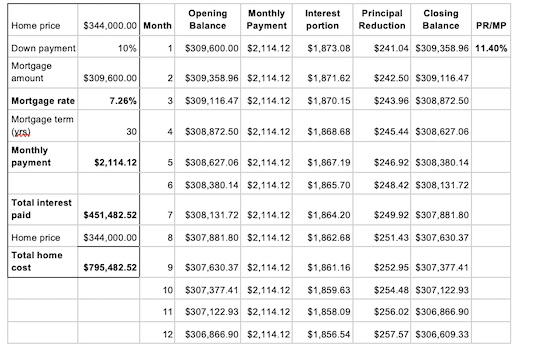
The numbers are alarming.
While the monthly payment is a mere $2,114.12, the total interest paid on the house is $451,482.52. This brings the total purchase cost to $795,482.52.
If you notice the top line of the mortgage amortization table I drew up, the last column is the principal reduction divided by the monthly payment. In this example, it’s only 11.40%. It takes a long time to cut into the principal of the mortgage.
But here’s the thing: Americans only have to worry if they can make the $2,114.12 payment. It never changes. That’s the beauty of the fixed rate.
My friend and colleague Alan Knuckman asked, “Where was everyone when rates were low?”
Let’s do the same example… but with the 2.65% historical low:
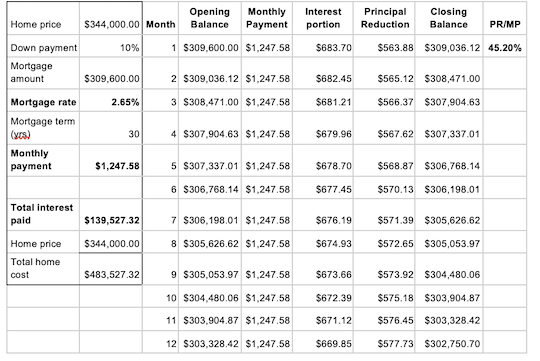
The difference is enormous.
The total interest paid and, by extension, the total home cost is over $300,000 less.
That’s because far more of the monthly payment reduces the principal (45.20%) from the get-go.
Now, looking at those examples, how are Rocket Mortgage, JPM, and Bank of America feeling about these higher rates?
Pretty damn good!
And they’re feeling especially good because the US housing market is still strong, despite Chairman Pow’s steep hiking cycle.
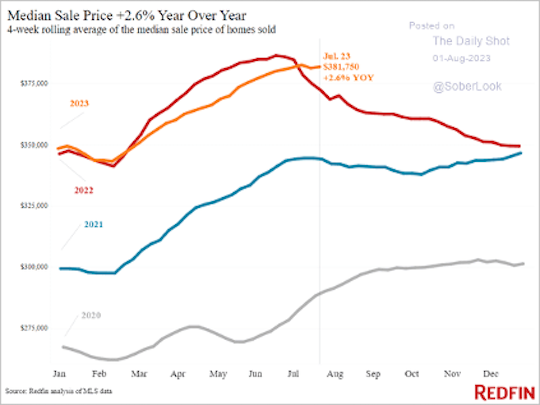
Credit: The Daily Shot
As you can see, most US mortgages aren’t linked to market rates. That is, they are fixed and not variable rate mortgages.
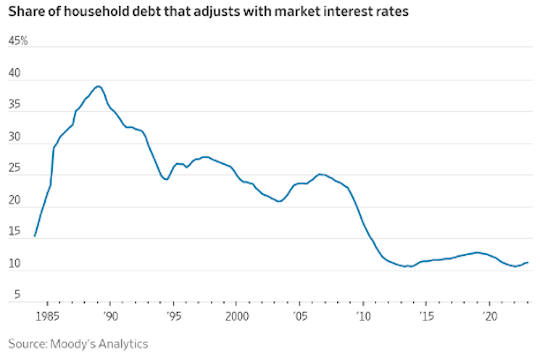
Credit: Charlie Bilello
To put this further into perspective, household debt service is a small part of disposable income:
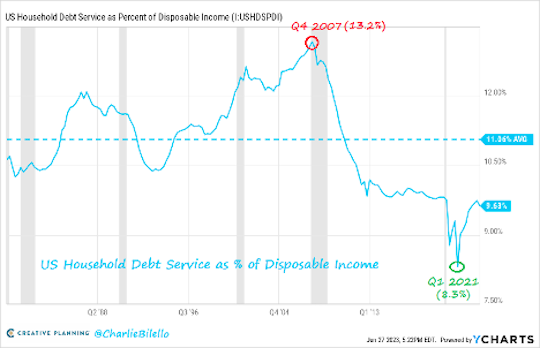
Credit: Charlie Bilello
The cost of all this is that starter homes are more expensive than ever.
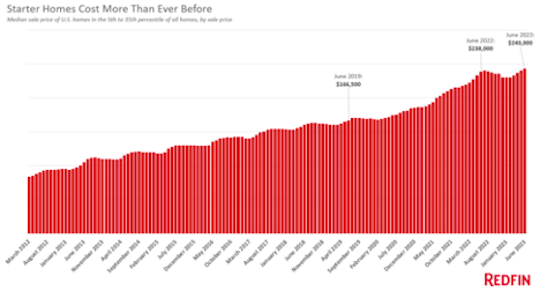
Credit: Charlie Bilello
This just puts more pressure on our poor demographics. After all, it’s much harder to start big families in little apartments.
All in all, the US housing market looks pretty good.
But how is it different in Europe?
European Blues
In Europe, usually, you can’t get a 30-year fixed mortgage.
In the UK, prospective homeowners can get a 2- to 10-year fixed mortgage, and then after the fixed term, it becomes a monthly floating rate mortgage.
Anecdotally, most people I know either get a 2-year fixed rate and keep rolling it or get an interest-only mortgage.
On the continent, most mortgages are floating rate mortgages. The rate is Euribor, the “Euro Interbank Offered Rate.” It’s the benchmark interest rate at which a panel of European banks offers to lend unsecured funds to one another in the euro wholesale money market.
Euribor is published daily by the European Money Markets Institute (EMMI) and serves as a reference rate for various financial instruments, including loans, mortgages, and derivatives, denominated in euros.
The floating rate mortgage is usually priced at Euribor plus a spread. The mortgage I’m looking at right now is Euribor + 190 bps (1.90%).
So Europeans have far less certainty about their monthly payments and, therefore, can’t plan as well as Americans can.
It may also explain why Europeans don’t mind renting for long periods.
Wrap Up
Since Americans have 30 years of home security, they can plan out their lives well in advance. But the cost can be the exorbitant interest they pay on their houses.
It’s their prerogative, but we shouldn’t wonder why bankers make so much money… especially when the American public pays them.
When preferences meet government-sponsored incentives, strange outcomes result.
Have a lovely day!


Comments: